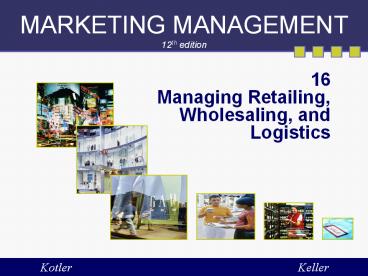MARKETING MANAGEMENT 12th edition PowerPoint PPT Presentation
Title: MARKETING MANAGEMENT 12th edition
1
MARKETING MANAGEMENT12th edition
- 16
- Managing Retailing,
- Wholesaling, and Logistics
Kotler Keller
2
Chapter Questions
- What major types of marketing intermediaries
occupy this sector? - What marketing decisions do these marketing
intermediaries make? - What are the major trends with marketing
intermediaries?
3
Starbucks Hear Music Coffeehouse
4
Retailing
Includes all the activities involved in selling
goods or services directly to final consumers for
personal, nonbusiness use.
5
Table 16.1 Major Retailer Types
- Specialty store
- Department store
- Supermarket
- Convenience store
- Discount store
- Off-price retailer
- Superstore
- Catalog showroom
6
Levels of Retail Service
Self-service
Self-selection
Limited service
Full service
7
Figure 16.1 Retail Positioning Map
8
Nonstore Retailing
Direct selling
Direct marketing
Buying service
Automatic vending
9
Major Types of Corporate Retail Organizations
- Corporate chain store
- Voluntary chain
- Retailer cooperative
- Consumer cooperative
- Franchise organization
- Merchandising conglomerate
10
Department Store Model Strong Retail Brand
Approach
11
Department Store Model The Showcase Store
12
Retailers Marketing Decisions
Target market
Product assortment
Service/store atmosphere
Price
Communication
Location
13
Retail Category Management
Define the category
Figure out its role
Assess performance
Set goals
Choose the audience
Figure out tactics
Implement the plan
14
Hot Topic offers merchandise first
15
Direct Product Profitability
16
Retailer Services Mix
Prepurchase services
Postpurchase services
Ancillary services
17
Location Decision
- General business districts
- Regional shopping centers
- Community shopping centers
- Strip malls
- Location within a larger store
18
Indicators of Sales Effectiveness
Number of people passing by
who enter store
of those who buy
Average amount spent per sale
19
Trends in Retailing
- New retail forms and combinations
- Growth of intertype competition
- Competition between store-based and
non-store-based retailing - Growth of giant retailers
- Decline of middle market retailers
- Growing investment in technology
- Global presence of major retailers
20
Private Labels
21
Wholesaling Functions
- Selling and promoting
- Buying and assortment building
- Bulk breaking
- Warehousing
- Transportation
- Financing
- Risk bearing
- Market information
- Management services and counseling
22
Major Wholesaler Types
Merchant
Full-service
Limited-service
Brokers and agents
Manufacturers
Specialized
23
Wholesalers Marketing Decisions
Target market
Product assortment
Price
Promotion
Place
24
Market Logistics Planning
- Deciding on the companys value proposition to
its customers - Deciding on the best channel design and network
strategy - Developing operational excellence
- Implementing the solution
25
Market Logistics Decisions
- How should orders be handled?
- Where should stock be located?
- How much stock should be held?
- How should goods be shipped?
26
Figure 16.2 Determining Optimal Order Quantity
27
Transportation Factors
- Speed
- Frequency
- Dependability
- Capability
- Availability
- Traceability
- Cost
28
Containerization
29
Marketing Debate
- Should national brand manufacturers
- also supply private label brands?
- Take a position
- Manufacturers should feel free to sell
- private labels as a source of revenue.
- 2. National manufacturers should never get
- involved with private labels.
30
Marketing Discussion
- Think of your favorite stores. What
- do they do that encourages
- your loyalty? What do you like about
- the in-store experience?

